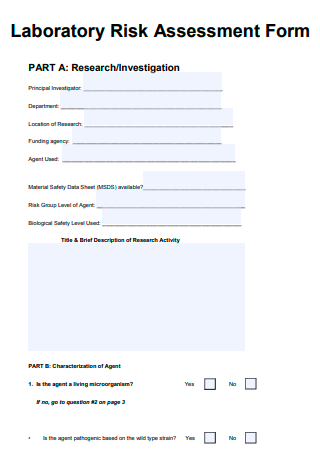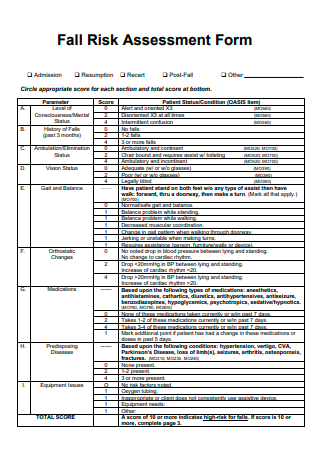20+ SAMPLE Risk Assessment Form
-

Risk Assessment Form Template
download now -

Exposure Risk Assessment Form
download now -

Basic Tree Risk Assessment Form
download now -

Stroke Risk Assessment Form
download now -

Risk Assessment Form For Hazardous Agents
download now -

Risk Assessment Form Example
download now -

Risk Assessment Short Form
download now -

Laboratory Risk Assessment Form
download now -

Travel Risk Assessment Form
download now -

Student Suicide Risk Assessment Form
download now -

Printable Risk Assessment Form
download now -

Risk Assessment Form in PDF
download now -

Site Specific Risk Assessment Form
download now -

Flat Roof Access Risk Assessment Form
download now -

Event Risk Assessment Form
download now -

Tuberculosis Risk Assessment Form
download now -

Health Risk Assessment Form
download now -

Fall Risk Assessment Form
download now -

Risk Assessment Form Format
download now -

Operational Risk Assessment Form Evaluation Scale
download now -

Reaction Risk Assessment Form
download now
FREE Risk Assessment Form s to Download
20+ SAMPLE Risk Assessment Form
What Is a Risk Assessment Form?
Components of a Risk Assessment Form
Types of Risk Assessment
Steps in Writing a Risk Assessment Form
FAQs
What is the goal of conducting risk assessments?
How often must the company conduct risk assessments?
Is there a difference between risk analysis and risk assessments?
What Is a Risk Assessment Form?
Alternatively, a risk assessment form is referred to as a security risk assessment form. It is defined as a document detailing the results of a risk assessment or the official consequence of the process of assessing risks, according to the National Institute of Standards and Technology (NIST). A thorough review of potential threats that a firm might encounter while implementing a plan must be completed before the report can be written by the company. If there are any risks identified, the firm can implement countermeasures such as processes and control procedures to reduce their impact on the organization. Fortunately, a risk assessment form has all of the required information that can assist in mitigating these dangers. The National Center for Atmospheric Research (NCAR) conducted a risk assessment effort that resulted in a modernization prioritization from various frameworks and improved records, with the rate of improvement increasing at a rate of 5 percent, according to a research paper published in the Data Science Journal entitled Risk Assessment for Scientific Data. There is a fault in the risk assessment report because there is no physical attribution of the risk and the report is entirely concerned with the framework.
We also have other themes that you can utilize at any time on our website if you require them. Real estate purchase contracts, buyout agreements, work contracts, Labor Contracts, position agreements, and staffing agreements are examples of the types of templates that are available. Other similar templates include: tenancy contracts, security bid proposals, and other forms of contract negotiation.
Components of a Risk Assessment Form
Risk assessments come in a variety of shapes and sizes, and each report follows a certain format that varies depending on the sort of risk assessment the business is conducting. Nevertheless, when it comes to the most important aspects of the risk assessment that are included in the report, the elements listed below demonstrate their relevance to the document.
Types of Risk Assessment
When it comes to producing risk assessment forms, keep in mind that there are many forms of risk assessment. It is critical for teams or individuals working on the report to have a diverse range of backgrounds and experiences, which will allow them to better manage the risks associated with each one. The sorts of risk assessments that are most frequently performed in diverse organizations are listed below.
Steps in Writing a Risk Assessment Form
Before moving on with your risk assessment processes, you must first define the scope and objective of the evaluation, as well as all of the resources that will be required, prospective stakeholders, and the statutory laws and regulations that will govern the evaluation. If you are not familiar with the process of preparing risk assessments, it can take a significant amount of time. Fortunately, there are actions you can take to ensure that your risk assessments are effective, and they are as follows.
Step 1: Identify and categorize all potential hazards.
The first stage in developing a risk assessment formi is identifying the threats that your employees are exposed to in the course of their everyday work. Make yourself familiar with the work lists of various teams and management levels. Physical, mental, chemical, and biological dangers that employees are exposed to, such as slips and trips on the floor, machinery, noise, excessive workloads, long hours and overtime labor, cleaning fluids, allergic responses, and infectious diseases, should be identified and documented in detail. Employees can provide you with vital information about problems or obstacles they are experiencing in their various lines of work.
Step 2: Identify the scenarios and individuals who will be exposed to the
The organization must conduct evaluations of its employees, visitors, clients, investors, and business partners, among other things. It is also the employer’s job to conduct an audit of work routines across several departments and geographical areas. It is also vital to specify responsibilities with regard to the health and safety of people who have disabilities or comorbidities, as well as night and shift workers, pregnant women, and nursing moms.
Step 3: Assess the dangers and implement precautionary measures
After identifying potential hazards and the people who may be affected by them, think about how each of these dangers creates harm and the intensity of that harm. It assists your organization in determining whether to implement new or refined steps to reduce the levels of risk, as well as which of these dangers should be given the highest level of importance.
Step 4: Make a note of your findings
When it comes to documenting your findings, the law requires businesses with more than five employees to do so. The report must include information about any hazards identified during the risk assessment, as well as the steps taken to minimize those risks and the persons who are impacted by them. The risk assessment report provides as evidence that a risk assessment was carried out as well as a basis for a review of working procedures. It must demonstrate that you have conducted adequate workplace checks, are regulating and dealing with hazards, have initiated risk mitigation techniques, and have involved your employees.
Step 5: Go over your risk assessments again.
Take into consideration the fact that workplaces and industries undergo fast change, which means that the risks faced by a company alter with time. Risk assessment reports must be reviewed on a regular basis to ensure that safe working practices and conditions continue to be followed, that new systems and equipment are taken into consideration, and that the report remains up to date with new dangers
FAQs
What is the goal of conducting risk assessments?
The main goal of risk assessments is to evaluate hazards, removing or mitigating their effects by researching, planning, and implementing control measures as the organization deems necessary. In doing so, you provide a safer and healthier working environment for your staff. It also answers essential questions about the possibilities of risks and their circumstances, possible consequences, probability of occurrence, the effectiveness of risk management, and further actions.
How often must the company conduct risk assessments?
There are various reasons for conducting risks assessments. Employers must administer risk assessments whenever new vacancies or jobs produces new hazards to the organization. Determine if vacancies are influenced by factors affecting turnovers and provide solutions, like employee surveys and training. It is also necessary to conduct risk assessments if changes are alerting the organization of new hazards, including an increase in leaves, issues on burnouts, and recurring absences. There is a need for risk assessments from the introduction of new machinery or processes.
Is there a difference between risk analysis and risk assessments?
Risk assessments help you identify possible risks and break them down into categories. It also provides an outline of potential consequences associated with identified risks. It involves systems and methods that classify, evaluate, and report all risk-related matters. Meanwhile, risk assessments involve crucial evaluation processes, determining the significance of risk factors. It also measures the likelihood of circumstances and resistances to these risks following particular events. It produces the possibility of prioritizing high-risk instances and set approaches to lessen their occurrence.
It is a necessary and mandatory step in any firm to incorporate risk assessment forms into their operations. These risk assessment reports serve to document the findings of risk assessments, which can then be used to help your firm reduce the negative effects of risks on employees and organizations. It is vital to identify and document these risks in order to develop useful alternatives and processes for the company that will lessen or totally eliminate these risks. It also aids in the assessment of these documents in order to make adjustments and enhancements that will benefit the organization in the long run. As Kelly Barnhill puts it, “That’s the beauty of revisions — every cut is important, and every cut hurts, but something new always emerges out of every cut.” Do not be frightened of making improvements and adjustments to your report because it will have a beneficial impact on the organization. Make use of and download the risk assessment reports listed above to begin protecting your company’s assets against potential threats to its operations.
